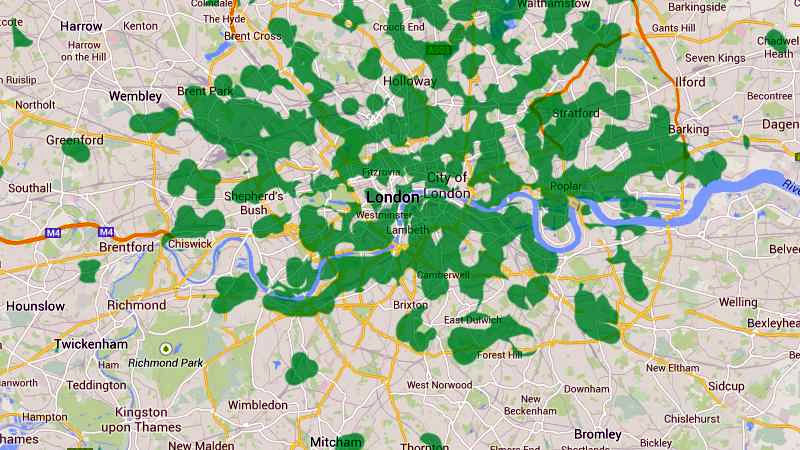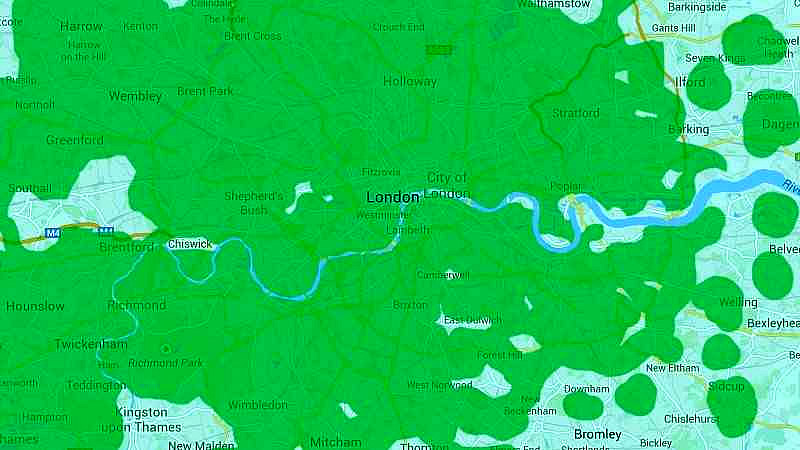While EE is currently focused on rolling out 5G, you don’t need this latest technology to get high speeds on the network, as EE has previously launched 4G+ in many areas, which is something of a middle ground between standard 4G and 5G.
So it’s faster than 4G, as well as having other benefits which we’ll explain below. However, it’s not available everywhere. Read on for all the details on what it is, how it works, where it’s available, how you can get it, and more.
What is 4G+?
4G+ is another name for LTE-A, LTE-Advanced or 4.5G and it’s basically a faster version of 4G. It works through carrier aggregation, which allows 4G phones to receive data from multiple bands in the 4G spectrum.
So while standard 4G only uses one band at a time, 4G+ can combine two bands for increased speeds. In EE’s case it’s the 1800MHz and 2.6GHz bands which are being combined.
Is 4G+ the same as EE’s double speed 4G?
No. EE has been offering a service known as double speed 4G in many locations for a long time now, but 4G+ is different and better. Double speed 4G doesn’t combine multiple spectrum bands, instead it allows customers to use more MHz from a single band, so while places with standard 4G might allow you to use 2 x 10MHz of 1800MHz spectrum, double speed would allow for 2 x 20MHz of spectrum.
But while it’s faster than standard 4G it’s not as fast as 4G+. Check out the next section for exact speed comparisons.
How fast is it?
4G+ theoretically offers peak download speeds of 300Mbps, though EE only promises speeds of up to 90Mbps. That’s far faster than even double speed 4G, which caps out at around 60Mbps, with typical download speeds of around 24-30Mbps.
Standard 4G meanwhile comes in at an average of around 20Mbps, so 4G+ is over four times faster. Or to put it another way a 30-minute HD video would take just around 2 minutes to download on 4G+, while it would take around 8 minutes to download with standard 4G.
Of course, it’s in a whole other league to 3G, which has average download speeds of around 3Mbps and even HSPA+ tends to be at around 6Mbps.
All that said, 5G is even faster still of course, with EE’s 5G network promising average speeds of around 130-240Mbps, with peak speeds potentially exceeding 1Gbps. So 4G+ is slightly old news in a sense, but it’s available in places that 5G isn’t, and you don’t need a 5G phone to take advantage of it.
How much does it cost?
4G+ doesn’t cost extra as such, but it’s not available on all plans. That said, it comes as standard on many of EE’s plans, including Smart plans, unlimited data plans, older 4GEE Max plans, and some (but not all) Essential plans.
If a plan says it comes with ‘the fastest 4G in the UK’, that means it includes 4G+, whereas if it says ‘up to 60Mbps data speed’ that means it tops out at EE’s double speed service, which now comes as standard.
You can get 4G+ on both Pay Monthly plans with a handset and SIM Only.
Does it have any other advantages over standard 4G?
Yes. It also increases network capacity in 4G+ locations, which means that not only will peak speeds be higher but you more consistently get a high speed, even when a lot of people are connecting at once. This is true for all EE customers, even those without a 4G+ compatible plan or handset.
Where is it available?
That’s a tricky question, as EE hasn’t released on update on 4G+ availability in a long time. Based on prior updates, 4G+ is available throughout most of greater London, out as far as the M25 and in some cases beyond. Large pockets of it can also be found in other areas, including Birmingham, Torquay, Manchester, Liverpool, Sheffield and more, with most cities and many towns having at least partial 4G+ coverage.
Given EE’s lack of updates the map above may be out of date, but it shows at least some of the places in London where 4G+ is available.
How can I get it?
To get 4G+ you’ll need to be in an area which has coverage. Beyond that you also need a supported plan (explained above) and a 4G+ compatible handset. To be 4G+ compatible it needs to be Cat.6 or above, but most modern smartphones are compatible.
This may seem confusing as Cat.4 devices theoretically support speeds of up to 150Mbps, but in real world use they tend to cap out far lower than that at around 60Mbps, while Cat.6 devices (which theoretically support download speeds of up to 300Mbps) can potentially achieve real world speeds of over 150Mbps.
Do any other networks have 4G+?
No other UK networks have a service called 4G+, but Vodafone has upgraded its equipment in London, Birmingham, Manchester, Liverpool, Cardiff, Nottingham, Bristol and elsewhere to allow for the same technology and speeds.
Three also has a similar service in major cities such as London, Birmingham, Cardiff, Edinburgh and Glasgow.
What does the future hold for 4G+?
While EE hasn’t spoken much about 4G+ recently, it’s presumably continuing to bolster its 4G service by upgrading sites to 4G+, and Three and Vodafone are likely doing the same thing.
However, we’re entering a new era now, with all the major networks primarily focused on 5G, which as noted above is even faster, so expect coverage of that to improve rapidly.









